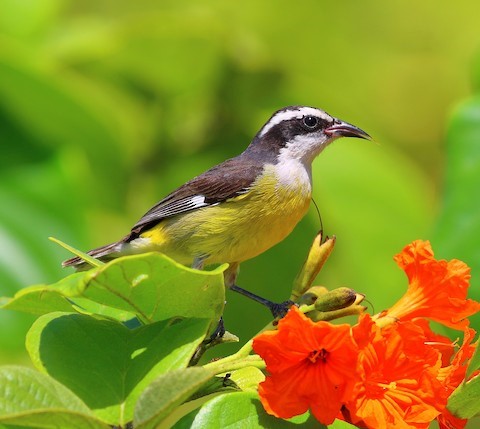Birdfinding.info ⇒ The Yucatán endemic form of Bananaquit is abundant on Cozumel, where it is easy to find at the frequently visited sites, such as Cha’an Ka’an Planetarium, El Cedral, and San Gervasio. Also common in Belize on Ambergris Caye and Caye Caulker. Generally uncommon and sporadic elsewhere.
“Cozumel Bananaquit”
Coereba flaveola caboti
Endemic to Cozumel, the Yucatán Peninsula, and adjacent islands. Apparently, most of the global population is resident on Cozumel, with a smaller, secondary population resident on Ambergris Caye and Caye Caulker, Belize.
Occurs regularly along the eastern coast from Isla Holbox and Cancún south to Sian Ka’an and the Belizean border. Sometimes also wanders west along the northern coast to Río Lagartos and occasionally inland.
Identification
Like all Bananaquits, readily recognized by its curved, sharp-tipped bill, broad white eyebrows, dark brown mask and upperparts, and yellow breast.
Other distinctive features include a yellow rump, yellow shoulders, and a large white spot at the base of the primaries. The gape at the base of its bill is partly pale-pink.

“Cozumel Bananaquit,” C. f. caboti. (Caye Caulker, Belize; June 4, 2019.) © Lee Jones
The “Cozumel Bananaquit” closely resembles the Bananaquit forms that inhabit the Bahamas, Cayman Islands, Providencia, and San Andrés. These forms all have a whitish throat that extends down to the upper chest and blends into the yellow of the breast—whereas the “Greater Antillean”, “Lesser Antillean”, and “Continental” forms have a smaller, dark gray throat that contrasts sharply with the vivid yellow chest.
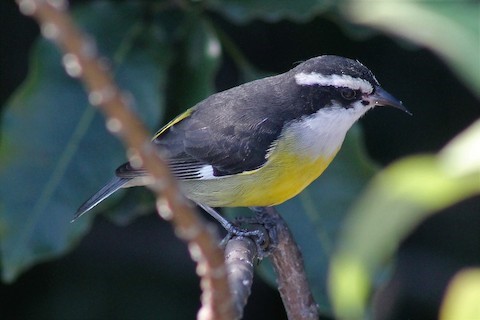
“Cozumel Bananaquit,” C. f. caboti. (Cozumel, Mexico; November 13, 2016.) © Greg Laverty

“Cozumel Bananaquit,” C. f. caboti. (Costa Maya, Quintana Roo, Mexico; March 15, 2018.) © Brandon Vanderslice

“Cozumel Bananaquit,” C. f. caboti. (Cha’an Ka’an Planetarium, Cozumel, Mexico; February 1, 2020.) © Chao “Jimmy” Wu
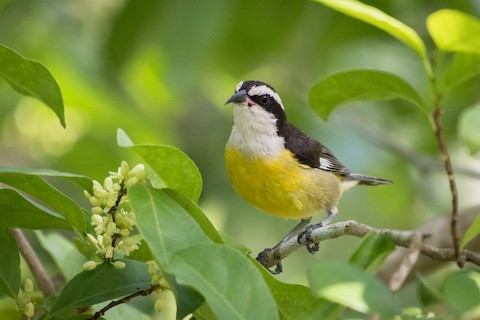
“Cozumel Bananaquit,” C. f. caboti. (Cha’an Ka’an Planetarium, Cozumel, Mexico; July 2, 2017.) © Apolinar Basora
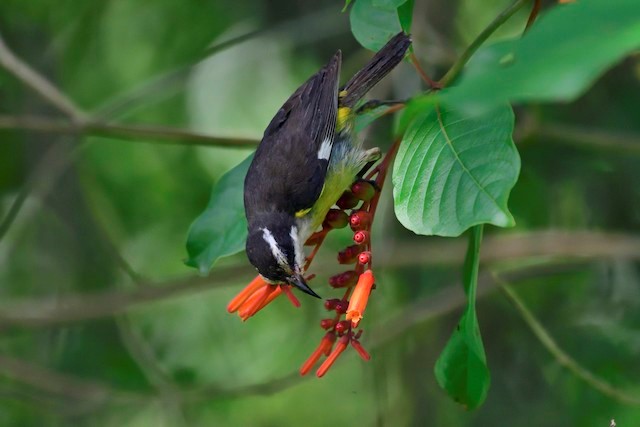
“Cozumel Bananaquit,” C. f. caboti. (Cozumel, Mexico; June 22, 2018.) © Luis Guillermo
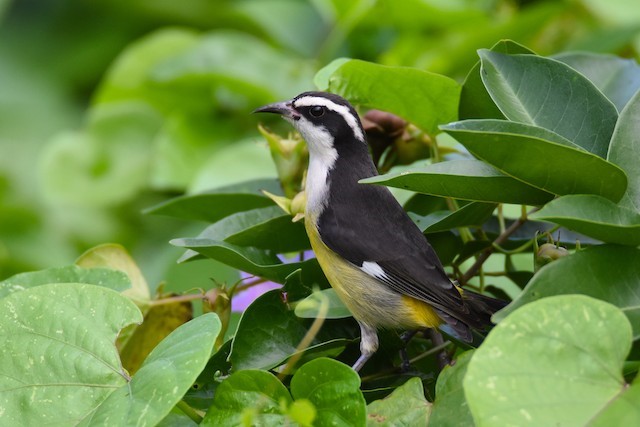
“Cozumel Bananaquit,” C. f. caboti. (Cozumel, Mexico; December 29, 2016.) © Luke Berg

“Cozumel Bananaquit,” C. f. caboti, showing yellow rump. (Caye Caulker, Belize; October 11, 2019.) © Roni Martinez
Immatures are similar to adults but have paler brown upperparts and dirty-yellow underparts and eyebrows.
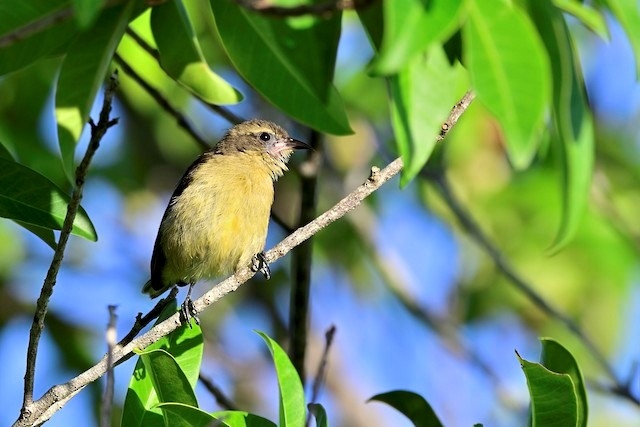
“Cozumel Bananaquit,” C. f. caboti, immature. (Cozumel, Mexico; September 28, 2018.) © Luis Guillermo
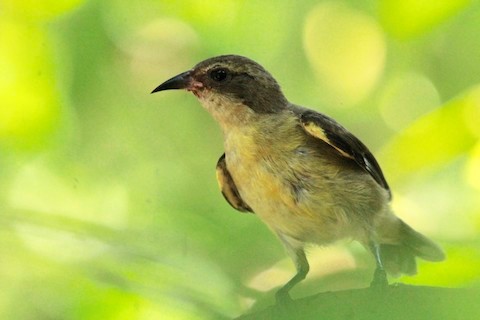
“Cozumel Bananaquit,” C. f. caboti, immature. (Punta Sur, Cozumel, Mexico; July 25, 2018.) © Zebedee Muller
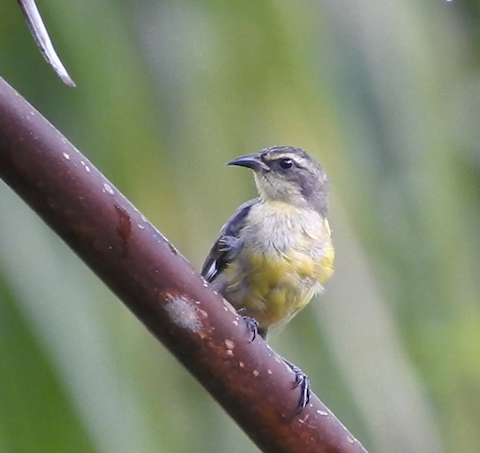
“Cozumel Bananaquit,” C. f. caboti, immature. (Punta Sur, Cozumel, Mexico; July 25, 2018.) © Zebedee Muller
Voice. Typical song consists of a pair of sharp notes followed by a clear sweet trill of about ten notes: Xamach Dos, Quintana Roo, Mexico; February 7, 2019. © Steve Hampton
Sometimes also gives a pair of buzzy descending notes: Caye Caulker, Belize; March 17, 2020. © Julio Hernandez
Calls also include “high, often lisping, thin to buzzy twitters, also a high, thin, sharp seiit or seeip” (Howell & Webb 1995).
Notes
Monotypic form, one of approximately five to ten potentially distinct forms of Bananaquit. The Cozumel form is often grouped together with the “Bahama” form. It also closely resembles the “Cayman” and “Providencia” forms in appearance, but differs vocally from all of them.
Frontiers of Taxonomy: Bunches of Bananaquits. The 43 or so subspecies of Bananaquit vary significantly in plumage and voice, and it seems clear that what has traditionally been recognized as a single species consists of several distinguishable forms, and likely two or more species, but it is a complex puzzle.
Mitochondrial DNA analysis (Bellemain et al. 2008) indicates that the oldest splits are among three lineages: “Bahama” (bahamensis, plus the “Cozumel” subspecies, caboti); “Greater Antillean” (Jamaican flaveola, Hispaniolan bananivora, “Cayman” sharpei, and possibly also the similar “Providencia” form, which includes tricolor and oblita); and the rest (which can be subdivided into “Lesser Antillean” and “Continental” groups).
References
Bellemain, E., E. Bermingham, and R.E. Ricklefs. 2008. The dynamic evolutionary history of the bananaquit (Coereba flaveola) in the Caribbean revealed by a multigene analysis. Evolutionary Biology 8:240.
Bellemain, E., O.E. Gaggiotti, A. Fahey, E. Bermingham, and R.E. Ricklefs. 2012. Demographic history and genetic diversity in West Indian Coereba flaveola populations. Genetica 140:137-148.
BirdLife International. 2016. Coereba flaveola. The IUCN Red List of Threatened Species 2016: e.T22722080A94747415. https://dx.doi.org/10.2305/IUCN.UK.2016-3.RLTS.T22722080A94747415.en. (Accessed April 15, 2021.)
eBird. 2021. eBird: An online database of bird distribution and abundance. Cornell Lab of Ornithology, Ithaca, N.Y. http://www.ebird.org. (Accessed April 15, 2021.)
Howell, S.N.G., and S. Webb. 1995. A Guide to the Birds of Mexico and Northern Central America. Oxford University Press, Oxford.
Seutin, G., N.K. Klein, R.E. Ricklefs, and E. Bermingham. 1994. Historical Biogeography of the Bananaquit (Coereba flaveola) in the Caribbean Region: A Mitochondrial DNA Assessment. Evolution 48:1041-1061.
Xeno-Canto. 2021. Bananaquit – Coereba flaveola. https://www.xeno-canto.org/species/Coereba-flaveola. (Accessed April 15, 2021.)
